
scrounge: /skrounj/ informal verb: to actively seek [books] from any available source
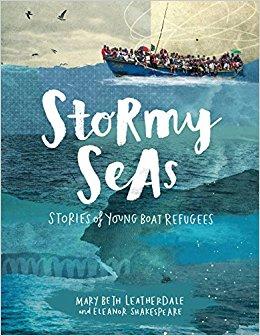
Stormy Seas is a timely look at young refugees of the past, especially considering the current refugee crisis in which more than five million people have fled Syria, half of whom are children. This book helps to show us that refugees are not new at all -- the young people featured in this book fled from Germany, Cuba, Vietnam, Ivory Coast, and Afghanistan, all due to violence, government oppression, or other threat of persecution.
Each of the five sections shares the story of one person's flight, the reasons for leaving, and a first-person account of their time on the boat. We are then given a summary of what has happened to them since these events. More than one of these desperate refugees were turned away from the country they had initially been trying to reach.
This book is well designed, with many photos and quotes set off from the main text, as well as maps and other illustrations to create visual interest. But what interested me the most were the stories of these refugees, who are humanized in these pages rather than appearing as statistics.
In the introduction, the author tells us:
"If you're reading this, you--like me--have probably won the lottery. Not the giant-check, instant-millionaire kind of lottery. The other lottery win--the really valuable one. That random, lucky break that means you were born in or immigrated to a relatively peaceful and prosperous place in the world."
It's not always something we're forced to think about, but this book helps young adults appreciate their situation by sharing the stories of others, and hopefully encourages empathy in our response toward those who simply want to survive.
(Thanks to NetGalley for the review copy.)
Scrounged From: NetGalley
Format: Kindle
Author: Mary Beth Leatherdale
Illustrator: Eleanor Shakespeare
Pages: 64
Content Advisory: Some depictions of violence, and of squalid conditions on the boats.
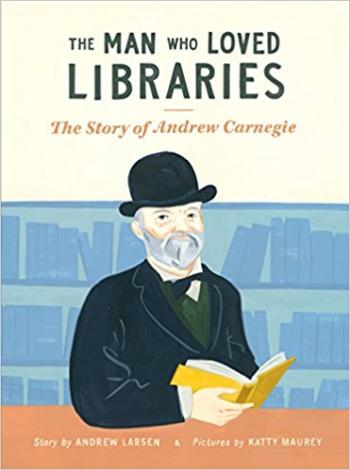
I really enjoyed this informative book about the life of Andrew Carnegie. I thought the pace of the story was well done -- it covered important information without getting bogged down in words, and the illustrations were nice too.
The narrative traces Carnegie's life from his poor beginnings in Scotland, to working his way up from factory worker to steel mogul in America, and then focuses on his charitable work building libraries all over the world.
At the end there were a couple pages of more detailed information, including the aside that Carnegie's relationship with his workers was "complicated," noting how he clashed with employees who were trying to unionize. Although this wasn't what the book was about, I appreciated this tidbit because it helped avoid putting Carnegie on too much of a pedestal -- though it was certainly inspiring to read about how he believed his riches were for giving away, and rather than just starting "charities," he truly wanted to empower people to help themselves.
(Thanks to NetGalley for the review copy.)
Scrounged From: NetGalley
Format: Kindle
Author: Andrew Larsen
Illustrator: Katty Maurey
Pages: 32
Content Advisory: None
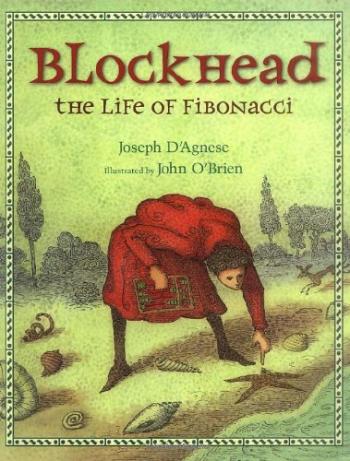
I'll be honest, words tend to hold much more interest for me than numbers. But that means that if I'm going to learn about a new mathematical concept, a picture book like Blockhead: The Life of Fibonacci is probably the best way to do so.
The author, Joseph D'Agnese, admits in the informational page at the end that very little is actually known of Fibonacci's life. So some aspects of this story are speculation, but we are told the basics: that Leonardo Fibonacci was born in Italy in the 1170s and became one of the greatest known Western mathematicians of the Middle Ages.
This book is written from a first-person perspective, and the title is taken from Fibonacci's nickname, "Bigollo," which could mean "traveler," but could also mean "idler, dreamer, or lazy person." In this story, Fibonacci's obsession with numbers leads to him being labeled as a "blockhead" by some, which of course is not true.
As we learn (through dialog with Fibonacci's friend, Alfredo), Fibonacci not only popularized the Hindu-Arabic numeral system that we use today, but he also noticed numerical patterns in the world around him that came up over and over again. This book includes an explanation of his "rabbit problem," (leading to the Fibonacci sequence) and a visualization of the golden ratio spiral. The illustrations include several other examples of the fibonacci sequence in nature, which readers are invited to go back and search for on the last page.
While the book does not really delve into the implications of these numbers, it still gave me a visually engaging way to learn about them, as well as an appreciation for Fibonacci's curiosity, and the incredible complexity of nature. As Fibonacci tells us at the end, "Now you see why I don't mind being called Blockhead, after all!"
Scrounged From: Amazon
Format: Hardcover
Author: Joseph D'Agnese
Illustrator: John O'Brien
Pages: 40
Content Advisory: None (though some may object to use of the phrase "mother nature")
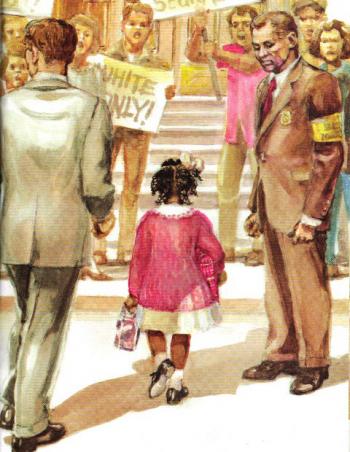
Book Scrounger's note: The following is a guest review by Doug, a.k.a. Professor Puzzler.
The Story of Ruby Bridges is a children's book which tells the story of the desegregation of William Frantz Elementary School in New Orleans. The story focuses primarily on Ruby's bravery, her faith, and her desire to find forgiveness for the mobs of angry people who wanted to stop her from attending the school.
Speaking of the mobs, author Robert Coles does an excellent job of describing the troubles that Ruby faced, at an age-appropriate level for a children's book. He speaks of angry mobs, and shouting, and protest signs, and of people wanting to hurt Ruby, but avoids discussing any of the specifics of the threats she faced. I liked this choice on the author's part, as it gives parents the freedom to discuss the more vicious aspects of the story when they feel it is most appropriate for their own children.
Robert Coles was probably best suited of anyone to write this book, as he was the child psychiatrist who met weekly with Ruby during her first year at Frantz Elementary. His work with Ruby led him, eventually, to write a book titled Children of Crisis: A Study of Courage and Fear, which he eventually developed into a series of books that won him the Pulitzer Prize in 1973.
Of course, any children's book is dependent not just on the author, but also on the illustrator; an illustrator can make or break a book. In this case, George Ford is an integral part of making this book a success. The illustrations are beautiful, with great use of light, shadow and coloration to draw attention to the focus of the book -- Ruby herself. Whether she is sitting alone in a classroom, with her family at church, or dwarfed by an angry mob and the marshals protecting her, it is always Ruby that captures your eye.
Scrounged From: Our local library
Format: Hardcover
Author: Robert Coles
Illustrator: George Ford
Pages: 32
Content Advisory: Thematic elements, as described above.
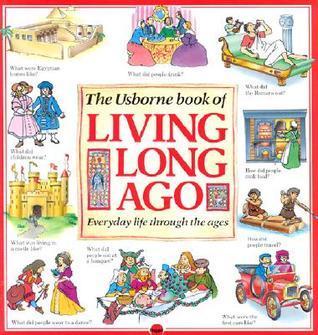
The Usborne Book of Living Long Ago is one of my favorite Usborne books from my childhood. Well, we actually had it as individual books, and we didn't have the fourth section, so I was even more excited to see a version where they're all together. I don't know whether this was ever used in my schooling or not -- it probably was, but what I remember most is finding it/them on the bookshelf as an older child and going back to it over and over again, looking at all the interesting tidbits.
In typical Usborne illustrations (lots of detail and explanations), we get to explore history through the lens of four basic issues that everyone has had to find solutions for throughout time (and very different ones, as we see): food, clothes, houses, and transportation. Each section is presented chronologically, from the earliest known people groups, to Egyptians, and Roman, Medieval, and Victorian times, among others, ending with (almost) modern day. It was always fun to compare and contrast the different time periods and find the same time period in each book to get a fuller picture of what life was like.
Scrounged From: HomeschoolClassifieds.com (Sonlight Core A)
Format: Paperback
Authors: Felicity Brooks and Helen Edom
Illustrators: Teri Smith
Pages: 96
Content Advisory: None

